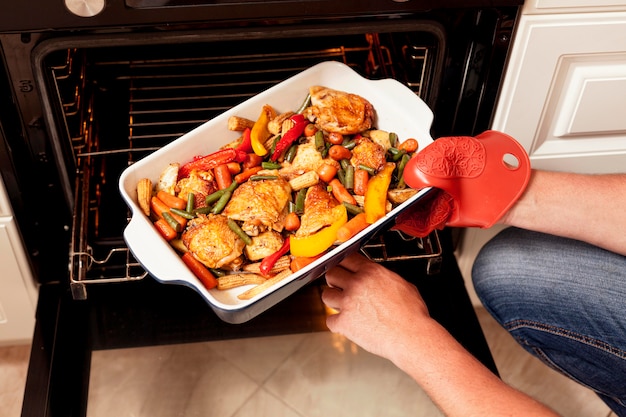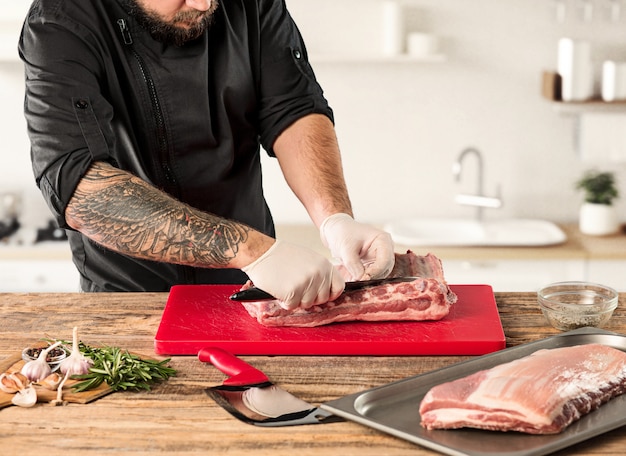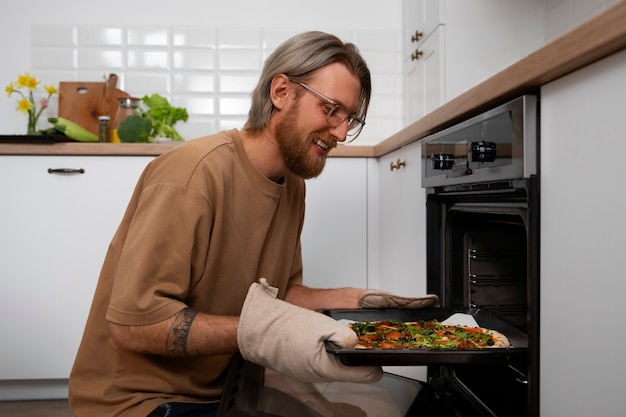(Part 1) The Basics: Understanding Doneness

Doneness Spectrum:
Rare: This is for the adventurous folks who like a cool, red center and a very soft texture. It's all about that raw, primal feeling. Medium Rare: This is a classic favourite, with a warm, red center and a slightly firm texture. It offers a balance of juiciness and a hint of cooked flavour. Medium: This is a good middle ground, with a pink center that’s getting closer to cooked through. It offers a firmer texture and a more pronounced flavour. Medium Well: The center is mostly cooked, with just a hint of pink remaining. It offers a firm texture and a richer flavour. Well Done: No pink whatsoever, the steak is fully cooked through. It offers the firmest texture and the strongest flavour, but can often be drier.Now, I know what you’re thinking: how do you actually know what “doneness” feels like? Well, the best way to get it right is by using a good ol’ fashioned meat thermometer. It’s a game-changer, especially if you're new to cooking steak. I’ve definitely had my fair share of overcooked steaks in the past, but a thermometer has become my trusty sidekick in the kitchen.
(Part 2) The Oven Steak Method: A Step-by-Step Guide

Step 1: Prepping Your Steak
First things first, we need to get your steak ready for its culinary transformation. Pat it dry with some kitchen paper. This helps ensure a beautiful sear and prevents any steam from forming during cooking. Next, season generously with salt and pepper. Remember, salt brings out the natural flavours of the meat, so don't be shy. You can also get creative with other seasonings like garlic powder, paprika, or even a pinch of chili flakes. I also like to add a bit of olive oil, which helps to create a crispy crust and keep the meat juicy.
Step 2: Preheat the Oven
Your oven is the key ingredient in this method, so we need to get it nice and hot. Preheat your oven to 400°F (200°C). This preheating step is crucial for achieving an even cook. Think of it as warming up the stage before the big performance.
Step 3: Searing the Steak
Now for the fun part: searing. This step is crucial for achieving a delicious, crispy crust and locking in those juicy flavours. Heat a heavy-bottomed skillet (cast iron is ideal) over a medium-high heat. You can add a little oil if needed, but I often find the natural fat from the steak is enough.
Carefully place the steak in the hot pan and sear for about 2-3 minutes per side. Don’t be tempted to move it around too much during searing. We’re aiming for a beautiful brown crust, not a scrambled mess.
Step 4: Cooking in the Oven
Once your steak has a good sear on both sides, carefully transfer it to a baking sheet lined with parchment paper. This will prevent sticking and make for easy cleanup later. Now, pop it into your preheated oven. Here's where the cooking times we'll discuss later come into play.
Step 5: The Importance of Resting
This is where many people go wrong. Don’t be tempted to dive into that perfectly seared steak as soon as it comes out of the oven. Let it rest for at least 5-10 minutes. This step is crucial for allowing the juices to redistribute evenly throughout the meat, resulting in a succulent, flavourful steak.
Imagine those juices as happy little explorers, finally getting the chance to travel around the entire steak and create a symphony of flavour. So, grab yourself a drink, relax, and let your steak rest.
(Part 3) Oven Steak Cooking Times: A Guide for Different Thicknesses

Cooking Times for 1-inch Thick Steak:
A one-inch thick steak is a good starting point for most ovens. Here are approximate cooking times for different levels of doneness:
| Doneness | Time |
|---|---|
| Rare | 5-7 minutes |
| Medium Rare | 7-9 minutes |
| Medium | 9-11 minutes |
| Medium Well | 11-13 minutes |
| Well Done | 13-15 minutes |
Cooking Times for 1.5-inch Thick Steak:
For a thicker steak, we need to give it a little more time in the oven. These are the approximate cooking times:
| Doneness | Time |
|---|---|
| Rare | 8-10 minutes |
| Medium Rare | 10-12 minutes |
| Medium | 12-14 minutes |
| Medium Well | 14-16 minutes |
| Well Done | 16-18 minutes |
Cooking Times for 2-inch Thick Steak:
If you’re feeling adventurous and going for a really thick cut, we need to up the game a little bit.
| Doneness | Time |
|---|---|
| Rare | 12-14 minutes |
| Medium Rare | 14-16 minutes |
| Medium | 16-18 minutes |
| Medium Well | 18-20 minutes |
| Well Done | 20-22 minutes |
Remember, these are just starting points. I always recommend checking the temperature with a meat thermometer to ensure you've hit your desired doneness.
(Part 4) Temperature is King: Using a Meat Thermometer
A meat thermometer is your trusty guide in the world of oven steak cooking. It’s like having a personal chef whispering in your ear, telling you exactly when your steak is ready. It eliminates the guesswork and ensures you don’t end up with a dry, overcooked disaster.
internal temperature Guide for Doneness:
Here's a handy guide for internal temperatures, to help you understand what’s happening inside that beautiful steak:
| Doneness | Temperature (℉) | Temperature (℃) |
|---|---|---|
| Rare | 125-130°F | 52-54°C |
| Medium Rare | 130-135°F | 54-57°C |
| Medium | 135-140°F | 57-60°C |
| Medium Well | 140-145°F | 60-63°C |
| Well Done | 145-150°F | 63-66°C |
I always suggest checking the temperature in the thickest part of the steak, avoiding the centre, as this can give an inaccurate reading.
(Part 5) The Art of Resting: Why It’s So Important
Resting is the unsung hero of oven steak cooking. It’s not just about letting the steak cool down; it’s about allowing those delicious juices to redistribute throughout the meat, resulting in a steak that’s juicy, tender, and bursting with flavour.
Why Resting is Key:
Retains Juices: When you cut into a hot steak, those precious juices run out, leaving you with a dry, disappointing meal. Resting helps to trap those juices within the steak, creating a symphony of flavour. Evenly Distributes Flavour: Resting allows the flavours to permeate the entire steak, ensuring that every bite is packed with goodness. Creates a More Tender Texture: The muscle fibres relax during resting, making the steak more tender and enjoyable to eat. Think of it as a luxurious spa treatment for your steak.A good rule of thumb is to rest the steak for at least 5-10 minutes, depending on the thickness. It might seem like a long time, but trust me, it’s worth it. You’ll be rewarded with a steak that's melt-in-your-mouth delicious.
(Part 6) Additional Tips for Oven steak perfection
Now, let’s sprinkle in a few more tips to elevate your oven steak game, turning you into a true steak maestro.1. Choose the Right Cut:
Not all steaks are created equal. For oven cooking, I recommend cuts that are naturally tender and have good marbling. These include ribeye, new york strip, and tenderloin. They're the superstars of the steak world, known for their rich flavour and tenderness.
2. Don’t Overcook:
This is a common mistake that can turn a beautiful steak into a dry, tough piece of disappointment. Keep a close eye on your cooking times and check the temperature regularly. It's better to undercook slightly and then rest the steak for a few more minutes.
3. Season Wisely:
Salt and pepper are the basics, but don’t be afraid to get creative with seasonings. Experiment with different herbs, spices, and rubs. I like to use a simple blend of garlic powder, onion powder, and paprika. You can also try adding a touch of chili flakes for a kick of heat.
4. Consider a cast iron pan:
Cast iron is a fantastic choice for searing. It retains heat exceptionally well, resulting in a beautiful brown crust. The heat from a cast iron pan will give your steak a fantastic sear, adding a delightful crunch and locking in those delicious flavours.
5. Use a Meat Thermometer:
I cannot stress this enough! It's the easiest way to ensure perfect doneness every time. It's your secret weapon to a consistently delicious steak.
(Part 7) Frequently Asked Questions
Now, let’s tackle those burning questions you might have about oven steak cooking:
1. Can I cook a steak in the oven without searing it?
You can, but you’ll miss out on that delicious crispy crust and the flavour it provides. Searing is a quick and easy step that makes a huge difference. It’s worth the extra few minutes for a flavour explosion.
2. How can I tell if a steak is done without a thermometer?
It’s tricky! The best way is to use the “poke” method. Press gently on the centre of the steak. If it feels firm, it’s well-done. If it’s slightly springy, it’s medium. If it’s soft and gives way easily, it’s rare. However, this method is not as accurate as using a thermometer. It’s a bit of a culinary gamble.
3. Can I cook multiple steaks at the same time in the oven?
Absolutely! Just make sure to leave enough space between the steaks on the baking sheet to allow for even cooking. You’ll have a delicious steak feast for everyone.
4. What can I do with leftover steak?
There’s nothing quite like a leftover steak! You can slice it thinly and add it to salads, sandwiches, or even use it for a delicious steak and cheese panini. It’s also perfect for making a hearty steak and potato soup.
5. Can I cook other cuts of meat in the oven using this method?
Yes, absolutely! This method is suitable for cooking other cuts of meat, like pork chops, chicken breasts, or even lamb. Just adjust the cooking times based on the thickness and type of meat.
(Part 8) Conclusion: The Final Bite
And there you have it, my friends! Oven steak cooking times, decoded. With these tips, you’ll be on your way to achieving juicy, delicious, perfectly cooked steak every time. Don't be afraid to experiment and find what works best for you. Now, go forth and conquer the kitchen!
Everyone is watching

Prime Rib Roast Cooking Time Chart: Per Pound Guide
Cooking TipsPrime rib roast. Just the name conjures images of lavish dinners, crackling fires, and hearty laughter. It’s ...

How Long to Bake Potatoes in the Oven (Perfect Every Time)
Cooking TipsBaked potatoes are a staple in my kitchen. They're incredibly versatile, delicious, and surprisingly easy to m...

Perfect Rice Every Time: The Ultimate Guide to Cooking Rice
Cooking TipsAs a self-proclaimed foodie, I've always been a bit obsessed with rice. It's the foundation of countless cuisi...

The Ultimate Guide to Cooking Asparagus: Tips, Techniques, and Recipes
Cooking TipsAsparagus. The mere mention of this spring delicacy conjures up images of vibrant green spears, crisp and burs...

Ultimate Guide to Cooking the Perfect Thanksgiving Turkey
Cooking TipsThanksgiving. Just the word conjures up images of overflowing tables laden with delicious food, the scent of r...
